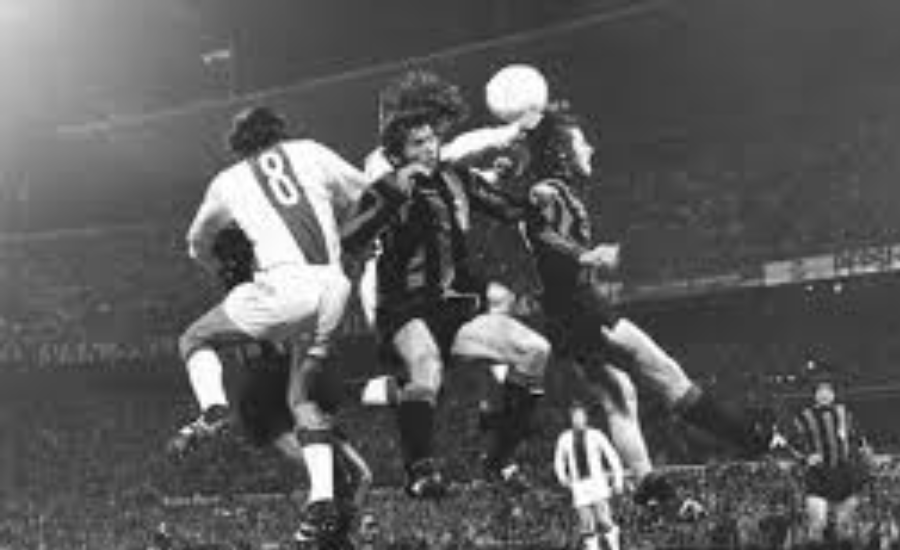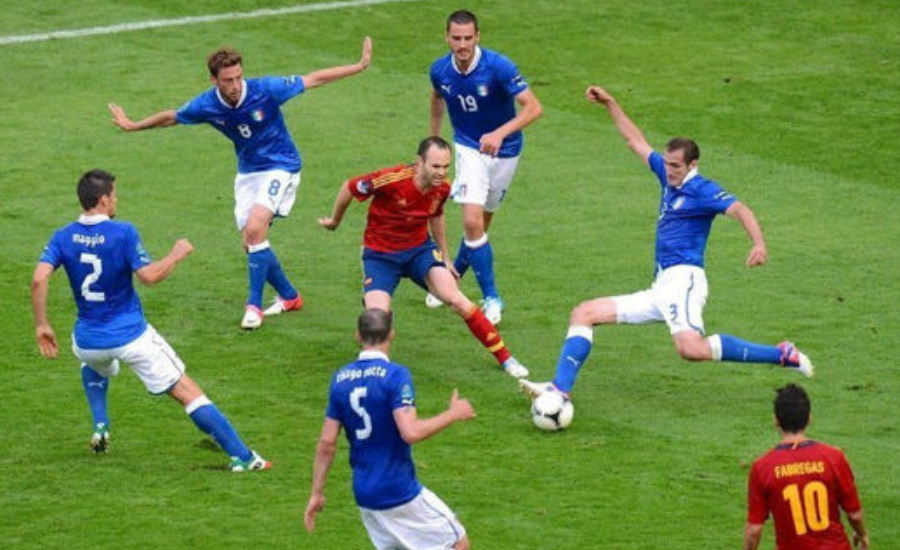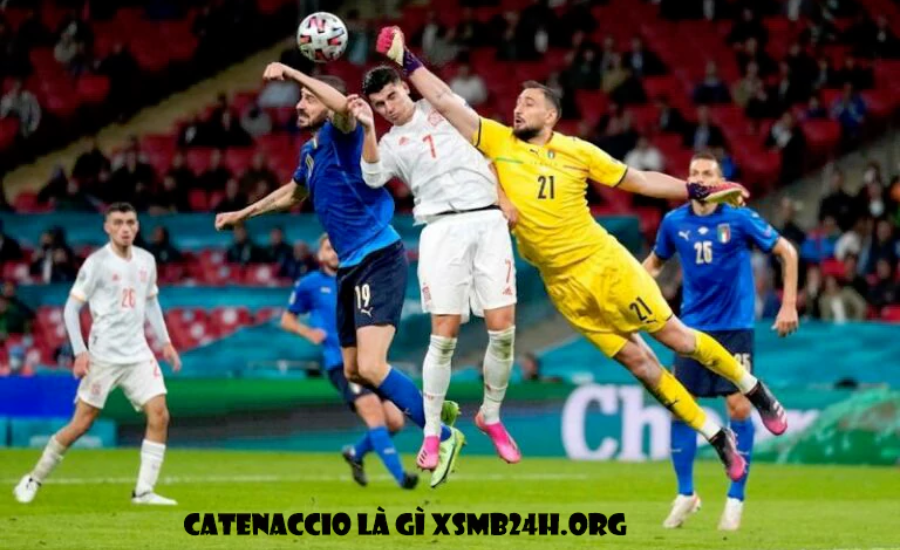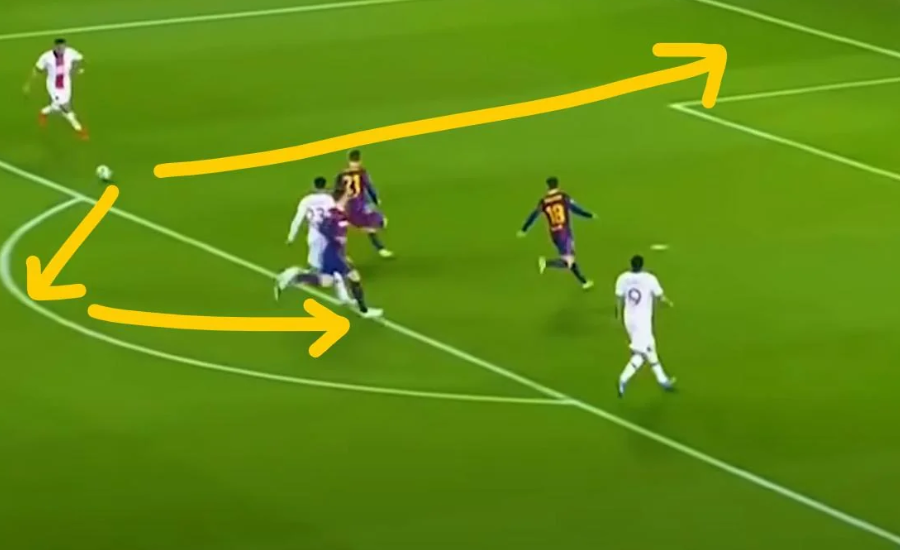
Catenaccio Là Gì XSMB24h.org? Tìm Hiểu Chiến Thuật Bóng Đá Đặc Trưng
The inquiry “Catenaccio là gì XSMB24h.org” invites us to delve into one of the most controversial and often misinterpreted tactics in football: Catenaccio. However, Catenaccio represents more than mere defense; it embodies a strategic philosophy that has profoundly influenced the evolution of football over the years.
In this article, we will thoroughly examine the essence of Catenaccio, tracing its historical roots and progression through various eras of the sport. We will also analyze its significant impact on contemporary football tactics, particularly in relation to discussions on platforms such as XSMB24h.org. By doing so, we aim to provide a clearer understanding of this tactical approach and its lasting legacy within the beautiful game.
Exploring the Concept of Catenaccio in Football
Catenaccio is a tactical approach in football that has its roots in Italian football culture, known for its distinctive focus on defense. The term “Catenaccio,” which translates to “door-bolt” in Italian, symbolizes the philosophy of reinforcing the goal with a well-structured and disciplined defensive formation.
This strategy prioritizes shutting down attacking opportunities, effectively creating a barrier that opponents find challenging to breach. Teams employing Catenaccio typically adopt a more conservative playing style, sacrificing aggressive offense for robust defense.
The tactical intricacies of Catenaccio involve not only positioning but also coordination among defenders, ensuring that every player is aware of their role in maintaining defensive solidity. By minimizing scoring chances for the opposition, this tactic aims to secure results, often leading to matches characterized by fewer goals but a high level of strategic play.
Catenaccio is not merely about defending; it represents a comprehensive strategy that has shaped the way football is played, particularly in Italy. Its influence continues to be felt in modern football, prompting discussions and analyses across various platforms.
The Historical Background of Catenaccio in Football

The concept of Catenaccio, often associated with its Italian origins, began to take shape during the 1940s and 1950s. This tactical approach emerged as a countermeasure to the prevalent attacking styles that characterized football in that era. Influenced significantly by the Swiss defensive system known as “Verrou,” which prioritized defensive strength and organization, Catenaccio sought to establish a more robust and secure defensive framework.
The term “Catenaccio,” which translates to “door-bolt” in Italian, encapsulates the essence of this strategy—creating a nearly impenetrable barrier against opponents.
At the heart of Catenaccio lies the role of the sweeper, or libero, a player positioned behind the main defensive line. This tactical innovation allowed the libero to effectively cover any defensive gaps, serving as a last line of defense against attacking plays. By bolting the door shut on opposing offenses, teams employing Catenaccio aimed to minimize scoring opportunities and control the tempo of the game.
Catenaccio’s introduction marked a pivotal shift in football tactics, steering away from the fluid, attack-oriented gameplay that had previously dominated the sport. Its focus on defensive organization has continued to influence football strategies, making Catenaccio a significant chapter in the evolution of the game.
Understanding the Mechanics of Catenaccio
Catenaccio fundamentally emphasizes structure, organization, and discipline within a football team. This tactical framework typically features a backline of four defenders, complemented by a pivotal player known as the sweeper. The primary responsibility of these defenders is to closely mark opposing forwards, ensuring that they have limited opportunities to exploit defensive weaknesses. The sweeper plays a crucial role by providing additional coverage and acting as a safeguard for the defensive unit.
The effectiveness of the Catenaccio system hinges significantly on the capabilities of the sweeper. To excel in this role, the sweeper must possess a high level of intelligence, quick decision-making skills, and exceptional positional awareness. Their ability to read the game and anticipate the movements of opponents is vital in maintaining a solid defensive structure.
Alongside the defense, midfielders play a crucial role in the Catenaccio strategy. They are responsible for disrupting the opponent’s attacking flow while simultaneously preparing for swift counter-attacks when chances arise. By breaking up plays and regaining possession, midfielders facilitate the transition from defense to offense, often setting up rapid attacks that can catch opponents off guard.
Ultimately, the combination of a well-organized defense, a savvy sweeper, and proactive midfielders makes Catenaccio a distinctive and strategic approach to football. This tactical discipline allows teams to effectively minimize their opponents’ scoring opportunities while creating openings for their own offensive maneuvers.
The Evolution of Catenaccio in Football History
The development of Catenaccio in the realm of football represents a fascinating journey through the tactical shifts that have occurred over the years. Originally conceived as a reaction to the more liberal and offensive styles of the early 20th century, Catenaccio gained prominence during the 1950s and 1960s, becoming a hallmark of Italian football. Influential coaches such as Nereo Rocco and Helenio Herrera played pivotal roles in refining this approach, leading iconic clubs like AC Milan and Inter Milan to significant victories through its disciplined and structured framework.
As the sport progressed, however, the rigid principles of Catenaccio began to adapt and evolve. The emergence of more dynamic and versatile systems marked a transition in tactical philosophy, with innovations like zonal marking and the gradual decline of the sweeper’s role reshaping how teams approached both defense and offense. In today’s football landscape, the classic form of Catenaccio is rarely employed in its original state; however, its foundational principles continue to resonate, particularly among teams that prioritize strong defensive organization and counter-attacking strategies.
Modern interpretations of Catenaccio often incorporate contemporary elements such as high pressing and ball possession tactics, blending traditional defensive solidity with the need for effective attacking transitions.
The influence of Catenaccio on today’s game is undeniable, as many teams draw on its legacy to formulate their defensive tactics. Its enduring impact is a testament to how foundational strategies can adapt over time, shaping the way football is played and understood in the modern era.
The Influence of Catenaccio on the Game of Football

Catenaccio has left a lasting mark on the world of football, particularly within Italy, where it established itself as a prevailing tactical approach for several decades. Teams that embraced Catenaccio were notoriously challenging to penetrate, often frustrating even the most formidable attacking squads. This defensive strategy, characterized by its rigorous organization and emphasis on shutting down opponents, created a reputation for its effectiveness in safeguarding goals.
However, Catenaccio has not been without its detractors. Critics argue that the tactic leans too heavily toward defensiveness, sometimes at the expense of the game’s creative and attacking elements. The rigid structure associated with Catenaccio can lead to matches that lack excitement and fluidity, as teams prioritize defense over offensive play.
Nevertheless, the essence of Catenaccio remains evident in contemporary football. Many elite clubs incorporate variations of this tactical framework, emphasizing solid defensive setups combined with swift counter-attacking opportunities. This adaptation reflects a broader understanding that defensive organization is crucial for success while still allowing for offensive play.
Catenaccio has also paved the way for the evolution of various modern defensive strategies, such as the “park the bus” tactic. This approach involves positioning a majority of players behind the ball to form a formidable barrier against opposing attacks. Teams utilizing this strategy often prioritize results over entertainment, mirroring the principles established by Catenaccio.
While Catenaccio may face criticism for its defensive tendencies, its impact on football tactics is undeniable. Its legacy endures, shaping the strategies employed by teams worldwide and influencing how the game is played today.
The Significance of Defensive Strategies within Catenaccio
Defensive strategies lie at the heart of the Catenaccio system, forming the backbone of its tactical approach. This method emphasizes a meticulously organized backline, typically consisting of four defenders, supplemented by a sweeper positioned strategically behind the defense. The primary purpose of this arrangement is to effectively thwart opposing attacks while reducing the chances of leaving exploitable gaps.
A cohesive and disciplined defensive unit is essential in Catenaccio, where every player understands their role and responsibilities. This unity fosters a resilient front that is difficult for adversaries to penetrate. The defenders work in tandem, tightly marking opposing forwards and anticipating their movements, while the sweeper serves as a crucial safety net, ready to intervene when necessary.
This defensive framework is not merely about blocking; it also emphasizes the importance of positioning and communication. Players must maintain awareness of their surroundings, ensuring that they can respond promptly to threats and support one another. The ability to quickly transition from defense to counter-attack is another key aspect, as Catenaccio allows teams to capitalize on opponents’ mistakes and create scoring opportunities when they least expect it.
Defensive strategies are indispensable to the Catenaccio tactic, forming a structured and cohesive unit that prioritizes defensive solidity. This careful orchestration not only protects the goal but also lays the groundwork for effective counter-attacking, showcasing the tactical depth that Catenaccio offers in the realm of football.
Essential Characteristics of Catenaccio
Catenaccio, often discussed on platforms like XSMB24h.org, is distinguished by its meticulously organized and disciplined defensive framework. This tactical approach prioritizes a formidable backline, typically composed of four defenders, complemented by a sweeper who plays a crucial role behind them. The sweeper acts as a safety net, tasked with neutralizing any threats that manage to breach the initial defensive line, thereby enhancing the overall security of the defense.
In this system, midfielders are not merely participants in attacking plays; they are also given significant defensive duties. These players frequently drop deeper into their own half, providing additional support to the backline. This dual responsibility underscores the commitment to maintaining a strong defensive presence throughout the match.
A hallmark of Catenaccio is its reliance on man-marking. Each defender is assigned a specific opponent to closely monitor and counter, ensuring that no attacking player is left unmarked. This strategy requires exceptional awareness and discipline, as players must stick to their assignments while being prepared to adapt to the fluidity of the game.
Although the primary focus of Catenaccio lies in its defensive solidity, it is not solely a defensive tactic. The system also emphasizes the importance of swift counter-attacks, leveraging the opposition’s offensive efforts to exploit any spaces left unguarded. When opponents commit players forward, Catenaccio teams seize these opportunities to launch rapid counter-attacks, often catching the opposition off-guard and creating high-quality scoring chances.
The key features of Catenaccio revolve around a structured defensive setup, where a robust backline, a vigilant sweeper, and proactive midfielders work in unison. This strategic framework not only fortifies the defense but also positions the team to capitalize on counter-attacking opportunities, highlighting the tactical sophistication that Catenaccio embodies in the world of football.
Exploring the Intersection of Catenaccio and XSMB24h.org

The phrase “Catenaccio là gì XSMB24h.org” highlights a fascinating dialogue between the defensive football tactic known as Catenaccio and the insights provided by the platform XSMB24h.org, which is renowned for its comprehensive coverage of various subjects, including sports. This platform serves as a vibrant hub for football enthusiasts to engage in discussions, debate strategies, and analyze the nuances of different tactics, including Catenaccio.
At XSMB24h.org, the discourse surrounding Catenaccio often centers on its relevance in the modern football landscape. As the sport evolves towards a more fluid and attack-driven style, critics contend that Catenaccio may no longer fit within contemporary strategies. They argue that the emphasis on defensive play can stifle creativity and excitement on the pitch.
Conversely, proponents of Catenaccio argue for its enduring principles, asserting that the tactic provides a robust foundation for teams aspiring to fortify their defense. They highlight the importance of structure, discipline, and organization that Catenaccio embodies, suggesting that these elements remain crucial for any team striving for success in an increasingly competitive environment.
XSMB24h.org not only facilitates these debates but also encourages fans to share their insights and experiences, creating a rich tapestry of opinions. Through detailed analyses, articles, and interactive discussions, the platform fosters a deeper understanding of how Catenaccio can be adapted and applied in today’s fast-paced football, ensuring that the conversation surrounding this historic tactic continues to thrive.
The intersection of Catenaccio and XSMB24h.org underscores the ongoing relevance of traditional football strategies in a rapidly changing game. By providing a forum for analysis and discussion, XSMB24h.org plays a pivotal role in keeping the conversation alive about this iconic tactic and its place in the future of football.
A Comparative Analysis of Catenaccio and Other Football Strategies
When analyzing football tactics, Catenaccio frequently emerges as a focal point of comparison with various other methodologies, such as high pressing and total football. Each tactic embodies distinct philosophies and strategic approaches to the game, showcasing the diverse ways teams can organize and execute their play.
Catenaccio, with its roots in defensive solidity, prioritizes a structured formation that aims to safeguard the goal. This tactic is characterized by a well-organized backline and the utilization of a sweeper to cover any vulnerabilities, ensuring that the defense remains tightly knit. Unlike the high-press strategy, which emphasizes an aggressive approach to regain possession in the opponent’s half, Catenaccio adopts a more conservative stance. It focuses on absorbing pressure and frustrating attacking teams before launching quick counter-attacks to exploit any gaps left by the opposition.
In contrast, total football presents a fluid and dynamic style, where players interchange positions and responsibilities seamlessly. This tactic relies on maintaining possession and creating space through movement, allowing for a more unpredictable and versatile approach to attacking play. While total football thrives on creativity and adaptability, Catenaccio is often viewed as a rigid defensive mechanism that can stifle creativity but is highly effective at neutralizing threats.
The distinctions between these tactics highlight the ongoing evolution of football strategies. Catenaccio’s emphasis on a disciplined defensive framework serves as a counterbalance to the more aggressive and fluid styles seen in contemporary football. While critics may argue that Catenaccio lacks excitement compared to high pressing or total football, its principles remain relevant, particularly for teams seeking to build a strong defensive foundation while also preparing for opportunistic counter-attacks.
Understanding Catenaccio in the context of other football tactics offers valuable insights into the tactical diversity within the sport. Each strategy, whether it be the steadfast defense of Catenaccio, the relentless pursuit of the high press, or the fluidity of total football, contributes to the rich tapestry of football tactics, allowing teams to adopt various approaches based on their strengths and the demands of the game.
Prominent Teams That Successfully Implemented Catenaccio
Catenaccio has been a defining tactic for several renowned football clubs, leading them to significant achievements both domestically and in European competitions. One of the most iconic examples is Inter Milan during the 1960s, a period marked by the tactical brilliance of coach Helenio Herrera. This era, often referred to as “La Grande Inter,” saw the team establish its dominance in Italian and European football, clinching multiple Serie A titles and securing consecutive European Cups.
Herrera’s interpretation of Catenaccio was notable for its adaptability, allowing for rapid transitions from defense to attack. While the foundational principles of the tactic—such as a strong defensive structure and the use of a sweeper—remained in place, Herrera’s approach also emphasized utilizing the pace of forwards to exploit counter-attacking opportunities. This blend of rigid defense and opportunistic offense set Inter Milan apart from their rivals during this golden age.
Similarly, AC Milan, under the management of Nereo Rocco, embraced Catenaccio to great effect. Rocco’s team not only won numerous domestic championships but also achieved international success, including two European Cups. The synergy between Rocco’s tactical mindset and his players’ abilities solidified AC Milan’s reputation as a powerhouse in football history.
These clubs have become synonymous with the Catenaccio strategy, demonstrating its effectiveness in achieving success on the pitch. Their triumphs not only popularized the tactic but also showcased how a disciplined and well-structured defense could serve as the foundation for winning football. The legacies of Inter Milan and AC Milan serve as enduring examples of how Catenaccio has shaped the sport, influencing future generations of teams and coaches.
The successful implementation of Catenaccio by these illustrious clubs underscores its significance in football tactics, leaving an indelible mark on the sport’s history and evolution.
Advantages of Catenaccio in Football

Catenaccio offers several key advantages that contribute to its effectiveness as a football tactic, particularly in terms of establishing a robust defensive framework while maintaining the potential for swift counter-attacks. One of the primary strengths of this system is its emphasis on organization and discipline, which creates a formidable barrier that is challenging for opposing teams to breach. As a result, opponents often experience frustration, leading to hasty decisions and unforced errors during matches.
Central to the Catenaccio strategy is the role of the sweeper, who acts as a crucial safety net for the defense. Positioned behind the primary defensive line, the sweeper is tasked with intercepting any threats that may arise, providing an additional layer of security. This player not only has the responsibility of clearing potential danger but also plays a pivotal role in initiating counter-attacks, making quick, strategic passes to forwards once possession is regained.
Another significant advantage of Catenaccio is its effectiveness in protecting a lead. When a team is ahead in the scoreline, the tactical setup allows them to absorb pressure from the opposition while limiting their scoring opportunities. The disciplined structure enables defenders to maintain their positions and cover gaps, effectively neutralizing attacking threats. This strategic resilience is invaluable in high-stakes situations where preserving a lead is critical.
Furthermore, the tactical reliance on rapid counter-attacks can catch opponents off guard, creating opportunities for sudden and impactful offensive moves. As the opposing team commits players forward in search of goals, Catenaccio teams can exploit the spaces left behind, turning defensive stances into quick, decisive attacks. This dual capability of strong defense combined with opportunistic offense has established Catenaccio as a formidable strategy throughout football history.
The strengths of Catenaccio lie in its ability to create a well-organized defensive structure, absorb pressure effectively, and launch quick counter-attacks. These elements make it a highly effective tactic that continues to influence teams and coaching strategies across the world of football.
Implementing Catenaccio in Modern Football
Although traditional Catenaccio is not commonly seen in contemporary football, many of its foundational elements remain valuable for teams looking to compete effectively. Particularly for underdog teams or those facing formidable opponents, adopting a defensive strategy can be an effective way to level the playing field. By emphasizing key principles such as tight marking, robust defensive organization, and rapid counterattacks, teams can effectively frustrate their adversaries and exploit any errors made during play.
One of the fundamental aspects of Catenaccio that modern teams can adopt is the importance of a cohesive defensive structure. This entails having defenders who work closely together, communicating effectively to maintain shape and minimize gaps that opponents can exploit. When players are well-drilled in defensive roles, they can stifle the opposition’s attacking movements, forcing them into less favorable positions on the field.
Additionally, teams that find it challenging to maintain possession or generate scoring opportunities through open play can significantly benefit from the tactical principles of Catenaccio. By prioritizing defensive solidity, these teams can create a strong foundation upon which to build their game. This approach allows them to focus on capitalizing on set-piece situations—such as corners and free-kicks—as well as executing quick counterattacks when the opportunity arises.
Furthermore, implementing Catenaccio-style tactics encourages teams to remain patient and disciplined. This mindset is crucial when facing stronger opponents, as it allows them to absorb pressure without succumbing to the temptation to overcommit in attack. By waiting for the right moment to strike, teams can turn defensive situations into offensive opportunities, often catching their opponents off-guard.
While pure Catenaccio may be less prevalent in today’s dynamic football landscape, its core principles can still provide a competitive edge. By integrating tight marking, strong defensive organization, and opportunistic counterattacks, teams can navigate challenging matchups effectively, achieving success even against stronger opposition.
The Future of Catenaccio in Football

As football evolves, the strategies and tactics utilized by teams around the globe also adapt accordingly. Although the traditional Catenaccio system may not dominate the game as it once did, its enduring legacy is undeniable. The foundational principles of robust defense, tactical discipline, and counter-attacking prowess are timeless elements that will always hold significance in football.
The essence of Catenaccio lies in its ability to adapt to varying contexts within the sport. In an era where teams are increasingly reliant on advanced technologies and data analytics, it’s plausible that we could witness the emergence of innovative adaptations of the Catenaccio philosophy. Coaches and analysts might leverage sophisticated metrics to refine defensive formations and enhance counter-attacking strategies, ensuring that the core tenets of Catenaccio remain relevant.
Furthermore, as football evolves, so does the understanding of how to implement defensive strategies effectively. With a greater emphasis on player fitness, teamwork, and game intelligence, teams may find new ways to integrate Catenaccio’s defensive solidity while blending it with modern attacking dynamics. This could lead to hybrid systems that retain the defensive rigor of Catenaccio but also incorporate elements of pressing and ball possession.
As these players rise through the ranks, they might bring fresh interpretations of Catenaccio to the forefront, enriching the game with their innovative approaches to defense and counter-attacking play.
While Catenaccio may evolve rather than remain static, its spirit and principles will persist in shaping how teams approach both defensive and offensive phases of play. As football progresses, the influence of Catenaccio will continue to inspire tactical creativity, ensuring that its legacy endures for years to come.
Facts
- Origin and Meaning:
- Catenaccio is an Italian term meaning “door-bolt,” symbolizing a defensive strategy focused on securing the goal.
- Tactical Philosophy:
- It prioritizes defense over offense, with a well-structured formation aimed at minimizing scoring opportunities for opponents.
- Key Components:
- Typically involves a backline of four defenders and a sweeper (libero) who acts as a last line of defense.
- Midfielders play dual roles, both defending and preparing for counter-attacks.
- Historical Roots:
- Emerged in the 1940s and 1950s as a response to more offensive styles, influenced by the Swiss “Verrou” system.
- Coaches such as Nereo Rocco and Helenio Herrera helped popularize this approach at clubs like AC Milan and Inter Milan.
- Modern Adaptations:
- While Catenaccio is rarely employed in its original form today, its principles are integrated into various contemporary strategies, such as high pressing and counter-attacking plays.
- Criticism and Legacy:
- Critics argue that it can lead to dull matches lacking creativity; however, its emphasis on defensive organization remains relevant in modern football tactics.
FAQs
Q: What is the main goal of Catenaccio?
A: The primary goal is to create a solid defensive structure that minimizes scoring chances for the opposing team while allowing for quick counter-attacks.
Q: Who popularized Catenaccio?
A: Coaches like Nereo Rocco and Helenio Herrera were instrumental in refining and popularizing the Catenaccio system in the mid-20th century.
Q: How does Catenaccio differ from other strategies?
A: Unlike offensive strategies that prioritize attacking play, Catenaccio is heavily focused on defensive organization, often employing a man-marking system to limit opponents’ offensive effectiveness.
Q: Is Catenaccio still relevant in modern football?
A: Yes, while its strict original form may be less common, its foundational principles influence many teams today, particularly those focusing on strong defensive setups.
Q: What are the criticisms of Catenaccio?
A: Critics argue that it can be overly defensive, resulting in less exciting games, and may inhibit creative attacking play.
Related: buy-qilszoxpuz7-4-0-8-bankroll-game/
Conclusion
Catenaccio stands as a pivotal tactical approach in football history, representing a blend of discipline, structure, and defensive solidity. While often misunderstood as merely a defensive tactic, it encompasses a strategic philosophy that has shaped the game over the decades. Its enduring influence can be seen in modern interpretations that prioritize defensive organization while still allowing for offensive opportunities. As football continues to evolve, the principles of Catenaccio provide valuable insights into the importance of balancing defense and attack, ensuring that this historical tactic remains relevant in contemporary discussions about football strategy. Platforms like XSMB24h.org play a crucial role in exploring and debating the significance of Catenaccio, keeping the conversation about this influential tactic alive.
Don’t miss out on updates and alerts – stay connected! : Mumbai Breaking

